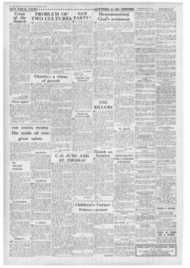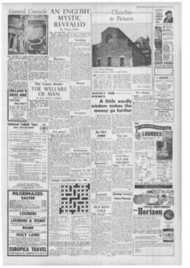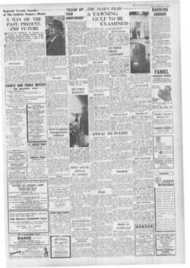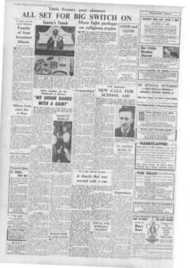Page 6, 29th December 1961
Page 6

Report an error
Noticed an error on this page?If you've noticed an error in this article please click here to report it.
Tags
Share
Related articles
Cardinal's Funeral
Cardinal Pizzardo Dies At 93
Florence's Cardinal Thanks The Canadians
Oldest Cardinal
World Await New Pope
Oldest Cardinal was the `Hildebrand' of Florence
`WE SHOOK HANDS WITH A SAINT'
THE oldest Cardinal in the Sacred College, a stern ascetic, once the tenacious foe of the Fascists, and himself the idol of Florence, Cardinal Elia Dalla Costa died there on Friday last at the age of 89.
He will be remembered above all else for the sacrifices he made for the poor and the sick, and for the bereaved families of men who fell in the war. It was he, too, who saved the city of Florence and its art treasures from ruin at that time.
He had been in failing health for several years, and latterly much of his work as Archbishop of Florence has fallen on the shoulders of his Coadjutor, Mgr. Ermenegildo Florit, Elia Della Costa was born in 1872 in the province of Vicenza. He was ordained in 1895 and secured a doctorate at Padua University. An outstanding scholar, his first years as a priest were years of ill-health, and he was sent to a country parish. Here he developed his natural gift for identifying himself with the humblest of his people.
PADUA
As Archpriest in Schio during World War I, he gained great respect from the allied armies for his patriotism and his efforts for the victims of the fighting. The Italian government gave him the Cross of Chevalier. The Supreme Command of the army praised him in the highest terms. The Ministry of Liberated Lands honoured him for his assistance to the wounded.
In his first sermon as Bishop of Padua in 1923, he sternly declared that the external majesty of the episcopacy would never dim his knowledge that he was a son of the people. and that the only real glory is that which comes from "goodness of life" and "holiness of work".
"I have never known the vile seductions of gold and silver," he said. "and that is why my appointment as Bishop of Padua finds me really poor." Pope Pius XI made him Archbishop of Florence and a Cardinal in 1931. He remained in his post at Florence until his death. On his appointment, he refused all celebrations and presents bar one —the revival of the traditional "Supper for 100 Poor", which, in past times, had been organised by a congregation called Vanchetoni, founded by the Blessed Hyppolite Gelatine in the 17th century to teach Christian doctrine.
The supper was given. But two rules were dispensed with—that which enjoined the shaving of beards and moustaches for reasons of cleanliness; and that which enjoined silence. The Cardinal and leading ecclesiastics served the guests, and when the Cardinal left the Oratorio, a great crowd aclaimed him for having "come to serve the poor".
LA PIRA
Throughout the thirties he was an outspoken critic of the Fascist regime, and had to be silenced by the civil authorities during the German occupation of Florence in World War 11.
After the liberation, he appealed for unity in post-war Italy and opposed reprisals against collaborators.
"Such ill-considered acts," he said, "have reactions often out of proportion to the provocation, even to the extent of compromising the security and lives of the innocent. It is horrifying to relate that today some feel that the wife must expiate for the acts of the husband, the son for those of the parents . . . " In 1944 and 1945, the Cardinal hammered, in his pastoral letters, the theme of unification and the exclusion of personal and party ambition. If selfishness were to triumph, he said, "we should fall again into the chaos from which the powerful hands of the allies have saved us."
Politics he saw as the "science necessary to promote the common
good". It was the duty of Christians to enter into political life to
prevent the triumph of abuse, violence, sectarianism and dictatorship, with all the threats these things imply against religion, family life and the common good. Women in particular were to be sure to go to the polls, especially when anything involving the preservation of Christian life was at stake.
During the Cold War era, the Cardinal worked with the famous Mayor of Florence, Catholic Action leader Giorgio La Pira. In 1955 the Mayor introduced the Soviet Ambassador to Italy and Mayors from six Communist countries to the Cardinal.
But just before the introduction, there was a special Mass included in the programme of the International Conference of Mayors of Capital Cities then taking place in Florence. The Cardinal presided at the Mass and then met the Communist officials, The Mayor said later, at a press conference: "Why not put the cause of peace into God's hands? What can we do for peace if we don't do that? The important thing is that we have all come together here, each in his own way, wishing for peace and welfare. and that we all together attended Mass, and all shook hands with a Cardinal who is truly a saint."
A tall, slight figure, Cardinal Dalla Costa had many of the characteristics of Hildebrand, later Pope Gregory VIL to whom he was often compared. He was a member of the Sacred Congregations of the Council, and of Seminaries and Universities.
blog comments powered by Disqus







